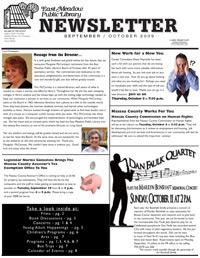Editor’s note: This is the first entry in a three-part series by Jude Schanzer. Read the second entry and the third entry.
I will start this piece with a confession: I am not a librarian. Ah ah ah … please don’t stop reading just yet. I was hired to be the programmer for the East Meadow Public Library because I am not a librarian. My background is in the professional performing arts and academia.
Our director at the time I was hired, John Franzen (who has sadly passed away), had an incredible sensitivity for where libraries were and where they had to go. John, a technophile, was always ready to add the latest and greatest piece of technology, though it still might be in the offing. He knew that if we were to serve the public we had to be a step ahead of our patrons and offer them what they wanted. Hmmm … we practice the same theory in the performing arts. You must be ahead of your audience so that they do not drop off from boredom. Nothing like standing on stage and looking out to a sea of nodding heads — unless it is standing in an empty library because everyone else has what you don’t.

How odd that I have been asked about arts programs in the library. Libraries are bastions of the arts. As a former denizen of the New York Library of the Performing Arts, I am used to the arts being part and parcel of what libraries do. Perhaps much of my confusion is because all libraries house the arts. Literature. Writing is an art. I do not care if you are writing a manual on how to install acoustical ceilings. Someone had to write it, and, hopefully, write it well. We do not need to turn to Shakespeare or Faulkner to count writing as an art form, though they are pretty good places to start. Bookmaking is an art form, and many libraries house books that fall into this category. So, we are already purveyors and caretakers of art.
Right now we, in some respects, are benefiting from the bad economy. Folks are discovering the library instead of buying books or renting DVDs. It is as if people have had this epiphany that the library does the same thing just as well, if not better, than books stores and DVD services, and for free. So, now we have to do what we do except more of it and with less money. A lot like the arts.
We all know that libraries are no longer confined to brick and mortar. Everyone has elaborate interactive web pages, databases, downloadable books, and some have downloadable movies. Patrons can reserve and renew books and DVDs online. Live programming is a great lure for patrons to actually walk into the building and stay for other things — like getting a book. And programming can stand alone, if it is quality programming and it is what the patrons want.
No longer can the library be looked at as only an informational and educational center. Some call us “community centers” now. I say we are “cultural centers,” with all that those words conjure up in our minds. Performance, visual arts, literature, history, discussion, innovative thought, and more are part and parcel of what can be found in a cultural center. Sounds like a library to me.
Furthermore, there is no reason that the arts must simply live side by side with the reference, children’s, young adult, and reader services of a library, but should be part of the workings of these departments. The arts can be integrated into the “why” of libraries. We are here to bring the best in education and information to all segments of our communities. The arts slide right in there so comfortably. Nearly every performance I plan has an educational support program accompanying it. If you are feeling squeamish about the place the arts really have in a library, remember the arts educate and inform as they entertain. Though I seem to have just done this, the arts need no excuse for their existence. They are part of the fabric of our beings and our cultures.
Whether we are presenting the complex mania and joy of Hamlet or witnessing the complex mania and joy of (yes) Oscar Madison and Felix Unger, we are reaching people. There are lessons learned. We bring people together. Patrons come together to create an audience; they share the experience of the live performance or the art show or the movie. They laugh together, they empathize together, and they rejoice together. People who may never have met share an experience. If it is a true success, each has a somewhat different experience within the framework of the event, and that event goes beyond the time they have spent in your library.


